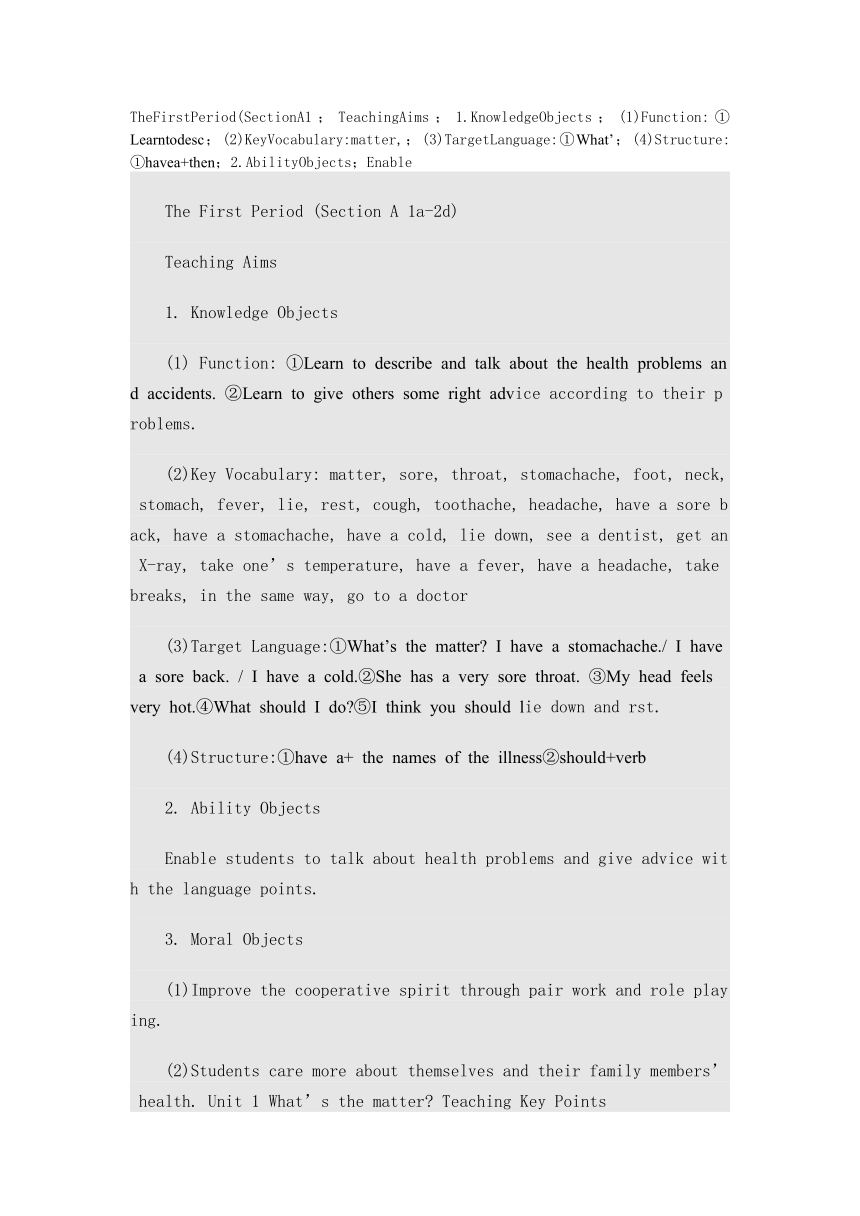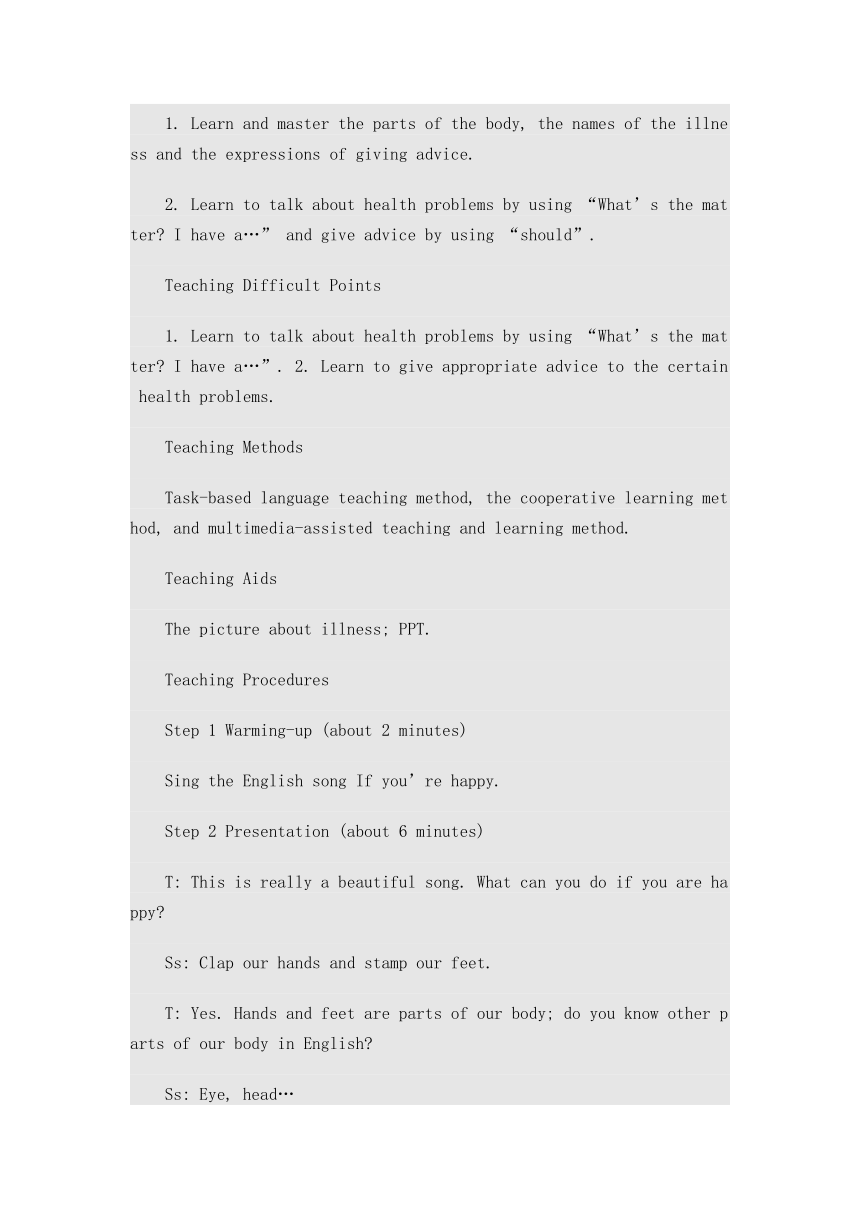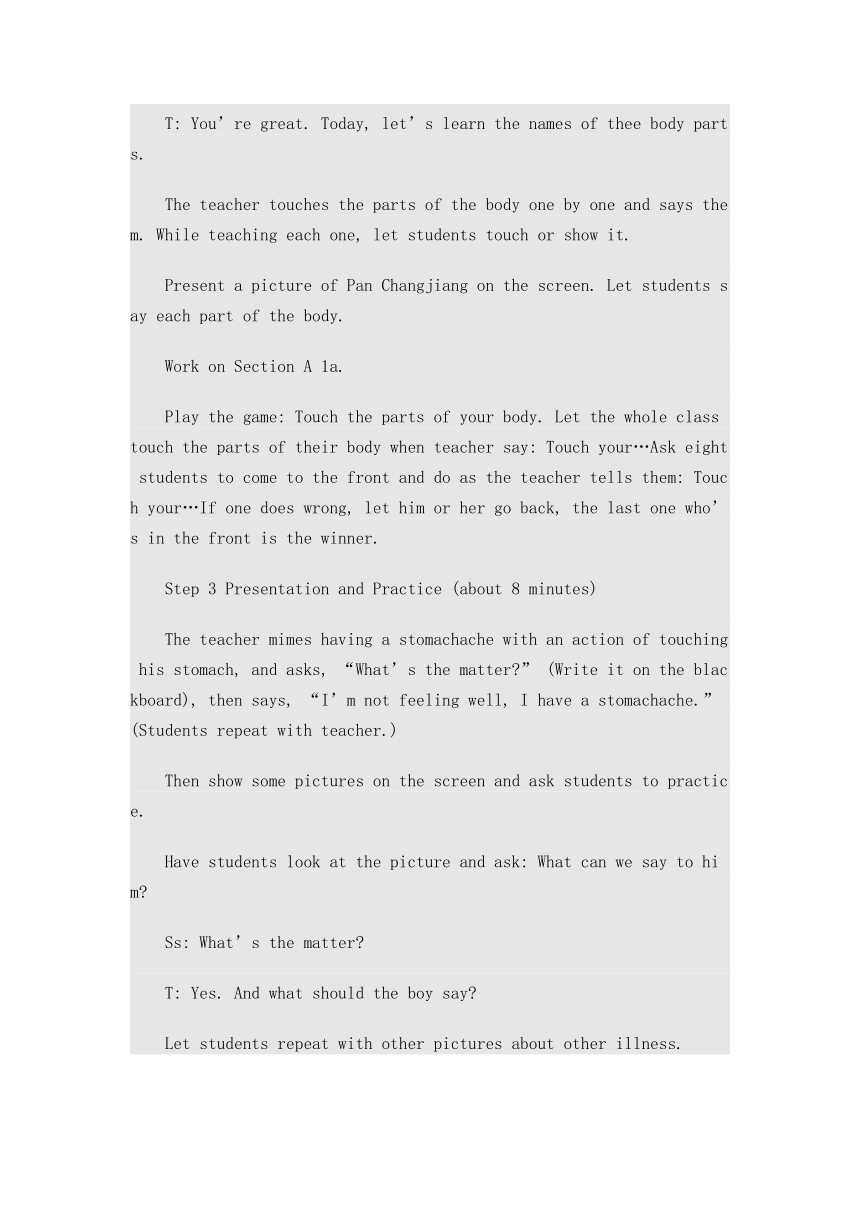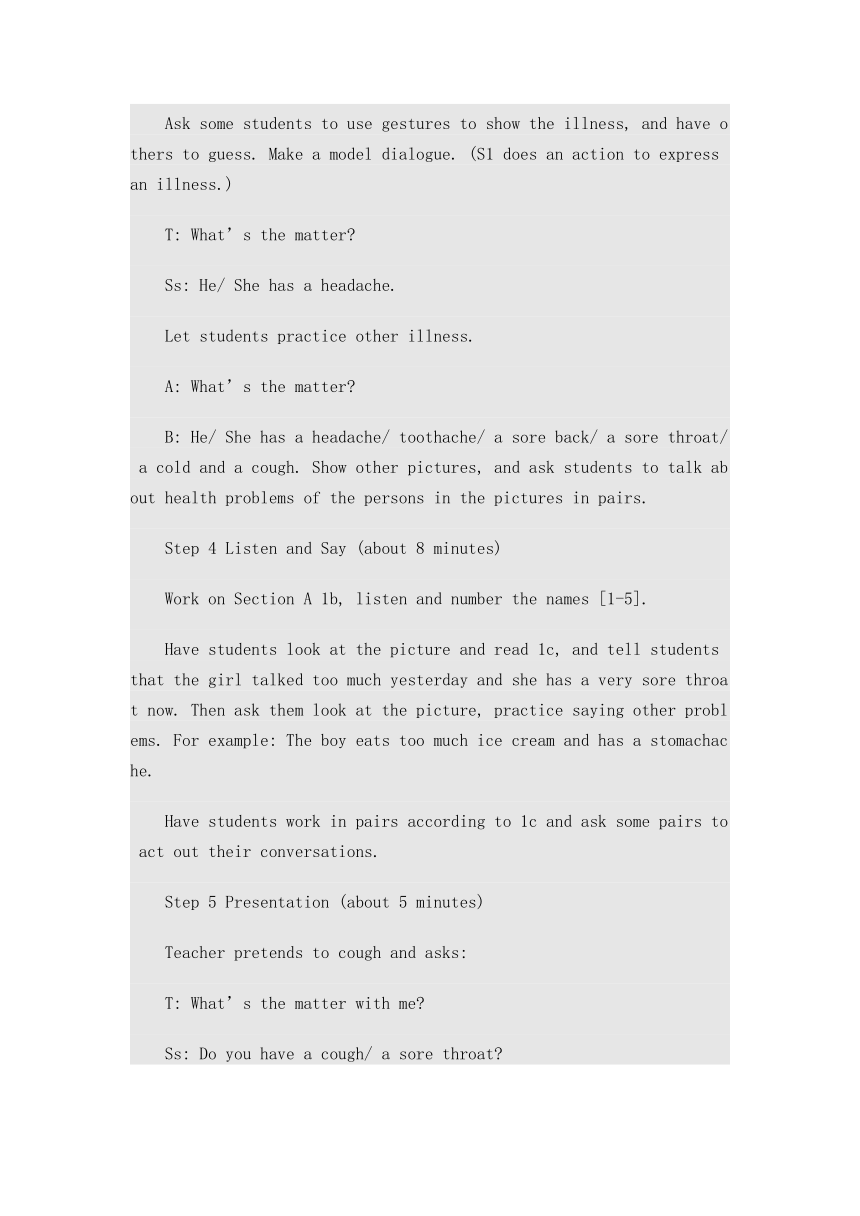Unit 1 What’s the matter?(Section A)教案
文档属性
| 名称 | Unit 1 What’s the matter?(Section A)教案 |  | |
| 格式 | zip | ||
| 文件大小 | 14.9KB | ||
| 资源类型 | 教案 | ||
| 版本资源 | 人教新目标(Go for it)版 | ||
| 科目 | 英语 | ||
| 更新时间 | 2014-03-04 19:52:44 | ||
图片预览




文档简介
TheFirstPeriod(SectionA1;TeachingAims;1.KnowledgeObjects;(1)Function:①Learntodesc;(2)KeyVocabulary:matter,;(3)TargetLanguage:①What’;(4)Structure:①havea+then;2.AbilityObjects;Enable
The First Period (Section A 1a-2d)
Teaching Aims
1. Knowledge Objects
(1) Function: ①Learn to describe and talk about the health problems and accidents. ②Learn to give others some right advice according to their problems.
(2)Key Vocabulary: matter, sore, throat, stomachache, foot, neck, stomach, fever, lie, rest, cough, toothache, headache, have a sore back, have a stomachache, have a cold, lie down, see a dentist, get an X-ray, take one’s temperature, have a fever, have a headache, take breaks, in the same way, go to a doctor
(3)Target Language:①What’s the matter I have a stomachache./ I have a sore back. / I have a cold.②She has a very sore throat. ③My head feels very hot.④What should I do ⑤I think you should lie down and rst.
(4)Structure:①have a+ the names of the illness②should+verb
2. Ability Objects
Enable students to talk about health problems and give advice with the language points.
3. Moral Objects
(1)Improve the cooperative spirit through pair work and role playing.
(2)Students care more about themselves and their family members’ health. Unit 1 What’s the matter Teaching Key Points
1. Learn and master the parts of the body, the names of the illness and the expressions of giving advice.
2. Learn to talk about health problems by using “What’s the matter I have a…” and give advice by using “should”.
Teaching Difficult Points
1. Learn to talk about health problems by using “What’s the matter I have a…”. 2. Learn to give appropriate advice to the certain health problems.
Teaching Methods
Task-based language teaching method, the cooperative learning method, and multimedia-assisted teaching and learning method.
Teaching Aids
The picture about illness; PPT.
Teaching Procedures
Step 1 Warming-up (about 2 minutes)
Sing the English song If you’re happy.
Step 2 Presentation (about 6 minutes)
T: This is really a beautiful song. What can you do if you are happy
Ss: Clap our hands and stamp our feet.
T: Yes. Hands and feet are parts of our body; do you know other parts of our body in English
Ss: Eye, head…
T: You’re great. Today, let’s learn the names of thee body parts.
The teacher touches the parts of the body one by one and says them. While teaching each one, let students touch or show it.
Present a picture of Pan Changjiang on the screen. Let students say each part of the body.
Work on Section A 1a.
Play the game: Touch the parts of your body. Let the whole class touch the parts of their body when teacher say: Touch your…Ask eight students to come to the front and do as the teacher tells them: Touch your…If one does wrong, let him or her go back, the last one who’s in the front is the winner.
Step 3 Presentation and Practice (about 8 minutes)
The teacher mimes having a stomachache with an action of touching his stomach, and asks, “What’s the matter ” (Write it on the blackboard), then says, “I’m not feeling well, I have a stomachache.” (Students repeat with teacher.)
Then show some pictures on the screen and ask students to practice.
Have students look at the picture and ask: What can we say to him
Ss: What’s the matter
T: Yes. And what should the boy say
Let students repeat with other pictures about other illness.
Ask some students to use gestures to show the illness, and have others to guess. Make a model dialogue. (S1 does an action to express an illness.)
T: What’s the matter
Ss: He/ She has a headache.
Let students practice other illness.
A: What’s the matter
B: He/ She has a headache/ toothache/ a sore back/ a sore throat/ a cold and a cough. Show other pictures, and ask students to talk about health problems of the persons in the pictures in pairs.
Step 4 Listen and Say (about 8 minutes)
Work on Section A 1b, listen and number the names [1-5].
Have students look at the picture and read 1c, and tell students that the girl talked too much yesterday and she has a very sore throat now. Then ask them look at the picture, practice saying other problems. For example: The boy eats too much ice cream and has a stomachache.
Have students work in pairs according to 1c and ask some pairs to act out their conversations.
Step 5 Presentation (about 5 minutes)
Teacher pretends to cough and asks:
T: What’s the matter with me
Ss: Do you have a cough/ a sore throat
T: Yes, I have a sore throat. Can you give me some advice What should I do
Ss: You should drink hot tea with honey/ shouldn’t talk too much/ go to a doctor…(Students can give different advice as they like)
Show different pictures to students, have them practice in pairs.
S1: What’s the matter with him/ her
S2: Yes, he/ she has a/ an toothache/ fever/ headache…(Teach the new words)What should he/ she do
S2: He/ She should go to see a dentist/ lie down and rest/ drink a lot of water./ see a doctor… He/ She shouldn’t drink cold water/ play basketball…
Work in groups, and have students role-play between a doctor and a patient. Ask them to talk about the health problems and give advice in groups.
Step 6 Practice (about 7 minutes)
Do 2a. Have students listen and number the picture [1-5]in the order they hear. Then check the answer.
Play the tape again for the students and let them do 2b by themselves.
Have students listen again and match the problems with the advice. Then play it again and check the answers.
Do 2c. Pair work. Let students read the conversations in 2c first. Then work in pairs, make a new conversation according to 2a and 2b. For example:
A: What’s the matter
B: My back feels terrible.
A: Maybe you have headache. You should see a doctor and get an X-ray.
B: That’s a good idea.
Show more pictures and let students make more conversations.
Step 7 Expansion and Extension (about 5 minutes)
Role-play the conversation.
First, have students to role-play the conversation in 2d in groups and choose the best. In groups, students discuss the language points and solve the problems. The teacher walks around and gives them some help if they need.
Work in groups. Have students do a survey in groups about their health problems, then discuss in groups and give some right advice and make a new conversation.
Ask each group to report their conversations.
Step 8 Summary (about 3 minutes)
Ask students to sum up the parts of a body and the names of illness.
Help students to sum up how to give advice by using “should” and “shouldn’t”, then ask them to give the right advice about different problems.
Step 9 Homework (about 1 minute)
Give advice to the following problems as much as possible: sore throat, toothache, headache, cold. Then choose one to make a dialogue with your partner.
Search on the internet about more advice of different health problems and accidents. Blackboard Design
Unit 1 What’s the matter
The First Period (Section A 1a-2d)
What’s the matter I have a stomachache/ sore throat/ a cold. She/ He has a very sore throat.
My head feels very hot.
What should I/he/she do You should/ shouldn’t…
第一课时作业设计
一、根据句意、汉语意思和首字母提示完成句子。
1. –What’s the m________ (问题)with you -I cut myself.
2. Tom didn’t go to school yesterday, because he had a sore t________ (咽喉).
3. A horse has four f________.
4. You should go to a doctor if you have a c________ (咳嗽).
5. The girl’s t_______ (牙齿)are very white and good. She brushes them twice a day.
二、汉译英。
1. 背痛________________ 2. 感冒______________ 3. 躺下休息_____________
4. 发烧________________ 5. 划伤自己_________________
三、选择填空。
( )1. What’s the matter with Lisa
A. She is away. B. She is cool.
C. She should get an X-ray. D. She has a sore throat.
( )2. –I’m too tired. I studied very late last night.
-I think you ____ have a good rest.
A. should B. has to C. shouldn’t D. needs
( )3. You should ____ for a few nights.
A. lies down B. lie down C. lie D. lie to
( )4. You shouldn’t eat ___ junk food.
A. much too B. too many C. too much D. many too
( )5. –I have a bad toothache. -____
A. What’s the matter B. You talks too much.
C. You should see a doctor. D. I think you should lie down and rest.
教学反思
本节课在教学中注意利用图片和教师的动作,从感官上刺激学生,能很快地抓住学生的注意力,再通过学生小组表演,给学生充分表现自己的机会,充分体现学生在教学中的主体地位。医生和病人的游戏一方面巩固了所学知识,另一方面训练了学生之间合作解决问题的能力,并通过给别人提出合理建议,让学生充满成就感。 多媒体辅助教学可以提高课堂教学容量,调动学生多个感官对知识的感知,实现信息传递的多渠道化,但要注意呈现的速度,做到张驰结合。
The First Period (Section A 1a-2d)
Teaching Aims
1. Knowledge Objects
(1) Function: ①Learn to describe and talk about the health problems and accidents. ②Learn to give others some right advice according to their problems.
(2)Key Vocabulary: matter, sore, throat, stomachache, foot, neck, stomach, fever, lie, rest, cough, toothache, headache, have a sore back, have a stomachache, have a cold, lie down, see a dentist, get an X-ray, take one’s temperature, have a fever, have a headache, take breaks, in the same way, go to a doctor
(3)Target Language:①What’s the matter I have a stomachache./ I have a sore back. / I have a cold.②She has a very sore throat. ③My head feels very hot.④What should I do ⑤I think you should lie down and rst.
(4)Structure:①have a+ the names of the illness②should+verb
2. Ability Objects
Enable students to talk about health problems and give advice with the language points.
3. Moral Objects
(1)Improve the cooperative spirit through pair work and role playing.
(2)Students care more about themselves and their family members’ health. Unit 1 What’s the matter Teaching Key Points
1. Learn and master the parts of the body, the names of the illness and the expressions of giving advice.
2. Learn to talk about health problems by using “What’s the matter I have a…” and give advice by using “should”.
Teaching Difficult Points
1. Learn to talk about health problems by using “What’s the matter I have a…”. 2. Learn to give appropriate advice to the certain health problems.
Teaching Methods
Task-based language teaching method, the cooperative learning method, and multimedia-assisted teaching and learning method.
Teaching Aids
The picture about illness; PPT.
Teaching Procedures
Step 1 Warming-up (about 2 minutes)
Sing the English song If you’re happy.
Step 2 Presentation (about 6 minutes)
T: This is really a beautiful song. What can you do if you are happy
Ss: Clap our hands and stamp our feet.
T: Yes. Hands and feet are parts of our body; do you know other parts of our body in English
Ss: Eye, head…
T: You’re great. Today, let’s learn the names of thee body parts.
The teacher touches the parts of the body one by one and says them. While teaching each one, let students touch or show it.
Present a picture of Pan Changjiang on the screen. Let students say each part of the body.
Work on Section A 1a.
Play the game: Touch the parts of your body. Let the whole class touch the parts of their body when teacher say: Touch your…Ask eight students to come to the front and do as the teacher tells them: Touch your…If one does wrong, let him or her go back, the last one who’s in the front is the winner.
Step 3 Presentation and Practice (about 8 minutes)
The teacher mimes having a stomachache with an action of touching his stomach, and asks, “What’s the matter ” (Write it on the blackboard), then says, “I’m not feeling well, I have a stomachache.” (Students repeat with teacher.)
Then show some pictures on the screen and ask students to practice.
Have students look at the picture and ask: What can we say to him
Ss: What’s the matter
T: Yes. And what should the boy say
Let students repeat with other pictures about other illness.
Ask some students to use gestures to show the illness, and have others to guess. Make a model dialogue. (S1 does an action to express an illness.)
T: What’s the matter
Ss: He/ She has a headache.
Let students practice other illness.
A: What’s the matter
B: He/ She has a headache/ toothache/ a sore back/ a sore throat/ a cold and a cough. Show other pictures, and ask students to talk about health problems of the persons in the pictures in pairs.
Step 4 Listen and Say (about 8 minutes)
Work on Section A 1b, listen and number the names [1-5].
Have students look at the picture and read 1c, and tell students that the girl talked too much yesterday and she has a very sore throat now. Then ask them look at the picture, practice saying other problems. For example: The boy eats too much ice cream and has a stomachache.
Have students work in pairs according to 1c and ask some pairs to act out their conversations.
Step 5 Presentation (about 5 minutes)
Teacher pretends to cough and asks:
T: What’s the matter with me
Ss: Do you have a cough/ a sore throat
T: Yes, I have a sore throat. Can you give me some advice What should I do
Ss: You should drink hot tea with honey/ shouldn’t talk too much/ go to a doctor…(Students can give different advice as they like)
Show different pictures to students, have them practice in pairs.
S1: What’s the matter with him/ her
S2: Yes, he/ she has a/ an toothache/ fever/ headache…(Teach the new words)What should he/ she do
S2: He/ She should go to see a dentist/ lie down and rest/ drink a lot of water./ see a doctor… He/ She shouldn’t drink cold water/ play basketball…
Work in groups, and have students role-play between a doctor and a patient. Ask them to talk about the health problems and give advice in groups.
Step 6 Practice (about 7 minutes)
Do 2a. Have students listen and number the picture [1-5]in the order they hear. Then check the answer.
Play the tape again for the students and let them do 2b by themselves.
Have students listen again and match the problems with the advice. Then play it again and check the answers.
Do 2c. Pair work. Let students read the conversations in 2c first. Then work in pairs, make a new conversation according to 2a and 2b. For example:
A: What’s the matter
B: My back feels terrible.
A: Maybe you have headache. You should see a doctor and get an X-ray.
B: That’s a good idea.
Show more pictures and let students make more conversations.
Step 7 Expansion and Extension (about 5 minutes)
Role-play the conversation.
First, have students to role-play the conversation in 2d in groups and choose the best. In groups, students discuss the language points and solve the problems. The teacher walks around and gives them some help if they need.
Work in groups. Have students do a survey in groups about their health problems, then discuss in groups and give some right advice and make a new conversation.
Ask each group to report their conversations.
Step 8 Summary (about 3 minutes)
Ask students to sum up the parts of a body and the names of illness.
Help students to sum up how to give advice by using “should” and “shouldn’t”, then ask them to give the right advice about different problems.
Step 9 Homework (about 1 minute)
Give advice to the following problems as much as possible: sore throat, toothache, headache, cold. Then choose one to make a dialogue with your partner.
Search on the internet about more advice of different health problems and accidents. Blackboard Design
Unit 1 What’s the matter
The First Period (Section A 1a-2d)
What’s the matter I have a stomachache/ sore throat/ a cold. She/ He has a very sore throat.
My head feels very hot.
What should I/he/she do You should/ shouldn’t…
第一课时作业设计
一、根据句意、汉语意思和首字母提示完成句子。
1. –What’s the m________ (问题)with you -I cut myself.
2. Tom didn’t go to school yesterday, because he had a sore t________ (咽喉).
3. A horse has four f________.
4. You should go to a doctor if you have a c________ (咳嗽).
5. The girl’s t_______ (牙齿)are very white and good. She brushes them twice a day.
二、汉译英。
1. 背痛________________ 2. 感冒______________ 3. 躺下休息_____________
4. 发烧________________ 5. 划伤自己_________________
三、选择填空。
( )1. What’s the matter with Lisa
A. She is away. B. She is cool.
C. She should get an X-ray. D. She has a sore throat.
( )2. –I’m too tired. I studied very late last night.
-I think you ____ have a good rest.
A. should B. has to C. shouldn’t D. needs
( )3. You should ____ for a few nights.
A. lies down B. lie down C. lie D. lie to
( )4. You shouldn’t eat ___ junk food.
A. much too B. too many C. too much D. many too
( )5. –I have a bad toothache. -____
A. What’s the matter B. You talks too much.
C. You should see a doctor. D. I think you should lie down and rest.
教学反思
本节课在教学中注意利用图片和教师的动作,从感官上刺激学生,能很快地抓住学生的注意力,再通过学生小组表演,给学生充分表现自己的机会,充分体现学生在教学中的主体地位。医生和病人的游戏一方面巩固了所学知识,另一方面训练了学生之间合作解决问题的能力,并通过给别人提出合理建议,让学生充满成就感。 多媒体辅助教学可以提高课堂教学容量,调动学生多个感官对知识的感知,实现信息传递的多渠道化,但要注意呈现的速度,做到张驰结合。
同课章节目录
- Unit 1 What's the matter?
- Section A
- Section B
- Unit 2 I'll help to clean up the city parks.
- Section A
- Section B
- Unit 3 Could you please clean your room?
- Section A
- Section B
- Unit 4 Why don't you talk to your parents?
- Section A
- Section B
- Unit 5 What were you doing when the rainstorm came
- Section A
- Section B
- Review of Units 1-5
- Unit 6 An old man tried to move the mountains.
- Section A
- Section B
- Unit 7 What's the highest mountain in the world?
- Section A
- Section B
- Unit 8 Have you read Treasure Island yet?
- Section A
- Section B
- Unit 9 Have you ever been to a museum?
- Section A
- Section B
- Unit 10 I've had this bike for three years.
- Section A
- Section B
